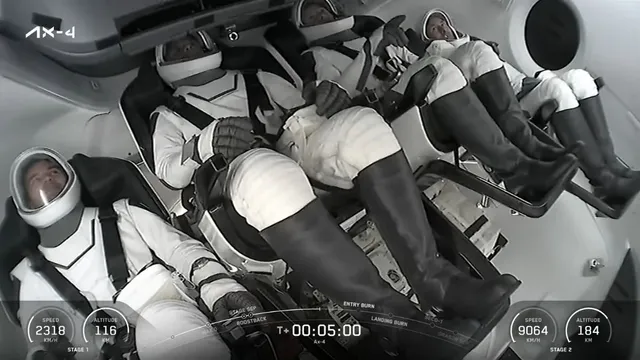- By Ajeet Kumar
- Wed, 25 Jun 2025 12:17 PM (IST)
- Source:JND
The Axiom Mission 4 launched aboard a SpaceX Dragon spacecraft from Launch Complex 39A at NASA's Kennedy Space Centre in Florida at 2:31 am Eastern Time (12 Noon IST). From India, Shubhanshu Shuka, Group Captain from the Indian Force, has joined the mission. This is the fourth private astronaut mission to the International Space Station. The crew is traveling to the orbiting laboratory on a new SpaceX Dragon spacecraft. The targeted docking time is approximately 7 am Eastern Time (4pm IST) on Thursday, June 26.
Liftoff of Ax-4! pic.twitter.com/RHiVFVdnz3
— SpaceX (@SpaceX) June 25, 2025
Shubhanshu Shukla's first message from space
As he lifted off, Shukla, in his first message from space, expressed joy for extraordinary ride, where he is moving at 7.5 km per second. "Namaskar, my dear countrymen! What a ride! We are back in the space once again after 41 years. It's an amazing ride. We are revolving around the Earth at a speed of 7.5 kilometres per second."
"The Tiranga embossed on my shoulders tells me that I am with all of you. This journey of mine is not a beginning to the International Space Station (ISS) but to India's Human Space Programme. I want all of you to be part of this journey. Your chest, too, should swell with pride...Together, let's initiate India's Human Space Programme. Jai Hind! Jai Bharat!," he added.
The four-member crew was carried aloft on a towering SpaceX launch vehicle consisting of a Crew Dragon capsule perched atop a two-stage Falcon 9 rocket. Live video showed the towering spacecraft streaking into the night sky over Florida's Atlantic coast trailed by a brilliant yellowish plume of fiery exhaust.
Liftoff of Ax-4! pic.twitter.com/RHiVFVdnz3
— SpaceX (@SpaceX) June 25, 2025
What will Shukla do during two weeks of space exploration?
Once docked, the astronauts plan to spend up to 14 days aboard the orbiting laboratory, conducting a mission comprised of science, outreach, and commercial activities. Peggy Whitson, former NASA astronaut and director of human spaceflight at Axiom Space, is in command of the mission, while Indian Space Research Organization Astronaut Group Captain Shubhanshu Shukla serves as pilot. The two mission specialists are European Space Agency project astronaut Slawosz Uznanski-Wisniewski of Poland and Tibor Kapu of Hungary.
The astronauts are using the new Axiom Extravehicular Mobility Unit (AxEMU) spacesuit which provides them with advanced capabilities for space exploration while providing NASA with commercially developed human systems needed to access, live and work on and around the Moon. The advanced spacesuits ensure astronauts are equipped with high-performing, robust equipment and are designed to accommodate a wide range of crew members.
Axiom-4 Mission: A major research program
The Ax-4 mission is going to be conducting major research. The research complement includes around 60 scientific studies and activities representing 31 countries, including the U.S., India, Poland, Hungary, Saudi Arabia, Brazil, Nigeria, UAE, and nations across Europe.
This will be the most research and science-related activities conducted on an Axiom Space mission aboard the International Space Station to date. NASA and ISRO (Indian Space Research Organisation) are collaborating to launch several scientific investigations.
These studies include examining muscle regeneration, growth of sprouts and edible microalgae, survival of tiny aquatic organisms, and human interaction with electronic displays in microgravity.
The first private astronaut mission to the station, Axiom Mission 1, lifted off in April 2022 for a 17-day mission aboard the orbiting laboratory. The second private astronaut mission to the station, Axiom Mission 2, also was commanded by Whitson and launched in May 2023 with four private astronauts who spent eight days in orbit. The most recent private astronaut mission, Axiom Mission 3, launched in January 2024; the crew spent 18 days docked to the space station.
The International Space Station is a convergence of science, technology, and human innovation that enables research not possible on Earth. For more than 24 years, NASA has supported a continuous human presence aboard the orbiting laboratory, through which astronauts have learned to live and work in space for extended periods of time.
(With inputs from agencies)

